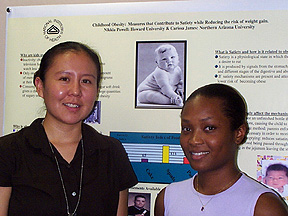
| T H E N I H C A T A L Y S T | S E P T E M B E R – O C T O B E R 2001 |
|
|
|
|
text
and photos |
DREAMS ON DISPLAY:
SUMMER STUDENTS BRING FRESH AIR TO A DOG DAY IN AUGUST
On August 9, more than 400 students left their summer homes in labs across the NIH campus to expose their research projects to the light of Poster Day and the inquiring minds of their colleagues. Nine of them captured by the Catalyst camera represent the gamut of students who summer in an NIH lab—from high school and college students to college grads and graduate students.
 |
Nikkia Powell (right), a junior at Howard University in Washington, D.C., and Carissa James, a junior at Northern Arizona University in Flagstaff, collaborated on their project on "Childhood Obesity: Measures that Contribute to Satiety while Reducing the Risk of Weight Gain" with preceptors Janice Yates and Barb Corey, CC Nursing Department. A Bowie, Md., native, Powell hopes to go to graduate school after she earns a nursing degree and would like to become a nurse-ethicist. James comes from Tuba City, Ariz., and is a member of the Navajo Nation. She would like to pursue nursing through the Indian Health Service after graduating from nursing school. "I learned a lot on the [CC] Alcohol Unit," James says. "You hear what patients have gone through. I can take that back to the reservation. You also learn about the research here. I would recommend the research experience to other students." |
|
Andrew Louie is a second-year medical student at George Washington University in Washington, D.C., who worked on "Characterization of Alanine Aminotransferase Elevation in Volunteer Whole Blood Donors" with preceptors Cathy Conry-Cantilena and Harvey Alter in the CC Department of Transfusion Medicine. Originally from Los Angeles, Louie will be the second generation of biomedical investigators in his family. He says his father was here some years ago, which may explain a certain familial partiality toward NIH. "I knew this was the mecca of research and wanted to see what it was like. I’ve had a very enjoyable time with excellent mentoring. . . . [it was] a wonderful way to learn, not just about my project but also about other health issues [presented at lectures for students]." |
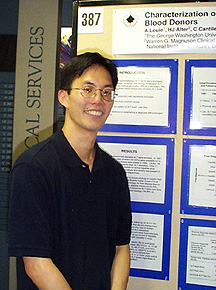 |
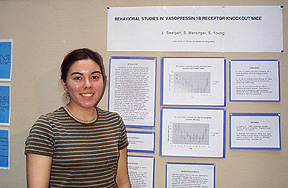 |
Joanna Sweigart is a postbac who attended Smith College in Northampton, Mass. The Houston, Texas, native worked in Scott Young’s NIMH lab with preceptor Scott Wersinger on "Behavioral Studies in Vasopressin 1B Receptor Knockout Mice." She expects to spend the next year working in Houston and studying for the MCATs. She dreams of pursuing internal medicine or geriatrics, but says that if things don’t come through on medical school applications next year, she’s thinking about doing a pre-IRTA year at NIH–an option she might have pursued this year if she hadn’t already made job commitments in Houston. "I’m amazed how many high school kids are here. I didn’t know anything about this when I was in high school. The only thing I knew about NIH was from the [children’s book] ‘Rats of NIMH’!" Sweigart’s discovery of the training opportunities at NIH came when an NIH scientist gave a lecture at Smith and tossed off the line, "If anyone wants to come and help with this research, I’m the only one doing it, and I’ll be glad to have you." Sweigart spoke to him after the lecture and said she’d be interested. "It was very lucky," she concludes.
|
|
Christopher Brewer (right), a junior at Abraham Lincoln High School in Philadelphia, discusses his poster on the "Regulation of MITF, a Transcription Factor Involved in Pigmentary/ Deafness Syndromes, by Phosphorylation: Initial Purification of Phospho-MITF-specific Antibodies" with NIDDK postdoc Kagnew Gebreyesus. Brewer’s preceptor was Keren Bismuth in the NINDS lab of Heinz Arnheiter. "It’s been great here–a totally new experience," he says. "I can’t wait to come back next year. I learned so much!" He hopes to go to college and some day become a neurosurgeon. |
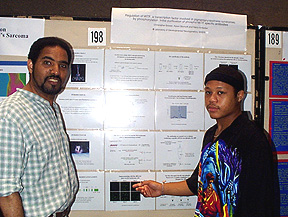 |
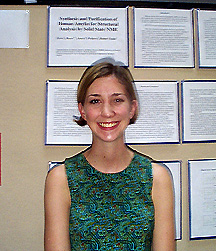 |
Erin Reese, a Virginia Commonwealth University School of Engineering (Richmond) senior, was in the Biomedical Engineering Summer Internship Program. Originally from Fredericksburg Va., Reese plans to continue with biomedical engineering in graduate school. She worked with preceptor Aneta Petkova in the NIDDK lab of Robert Tycko on the "Synthesis and Purification of Human Amylin for Structural Analysis by Solid State NMR." "This program," she says, "showed me what the research process is like. . . . it was an excellent experience, and I would recommend something like this for someone else." |
|
Curtis Henry, a junior at Florida A & M in Tallahassee, worked in Roscoe Brady’s lab in the NINDS Developmental and Metabolic Neurology Branch, where with preceptor Gary Murray he pursued the "Purification and Properties of Mutant Glucocerebrosidase Expressed in 293 Cells." Henry says "this was a life-changing experience. It affirmed my goals to become an immunologist and pursue a Ph.D. I would love to come back to NIH to finish this research–or go on to something else." |
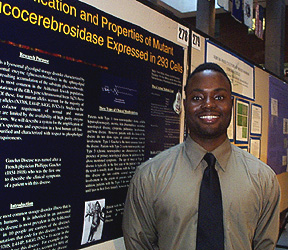 |
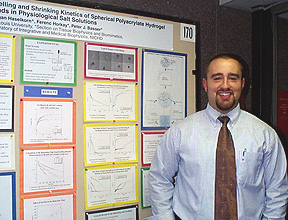 |
Keegan Haselkorn, a St. Louis University senior, was in the Biomedical Engineering Summer Internship Program and worked with Ferenc Horkay in Peter Basser’s NICHD lab. His project was on the "Swelling and Shrinking Kinetics of Spherical Polyacrylate Hydrogels in Physiological Salt Solutions." Haselkorn is now applying to graduate schools and hopes to pursue a doctorate in biomedical engineering. The summer program, he says, helped him decide what specialties he might enjoy. "NIH has a great learning atmosphere. You get to do research, but you have the mentors there to help you along. The most surprising thing was that I was able to get results and produce something publishable in 10 weeks. I didn’t think it was possible to be very productive in such a short time!" |
|
Ethan Bromberg-Martin, who just graduated from George C. Marshall high school in Falls Church, Va., will be attending Brown University in Providence, R.I., in the fall. He worked under preceptor Brian Mozer in the NHLBI Laboratory of Biochemical Genetics of Marshall Nirenberg to complete his project on "The Molecular Genetics of Neural Development in Drosophila." "The most interesting thing," he says, was working in a lab and seeing what genetics research is like." Bromberg-Martin is not sure what he’ll pick for his major but is thinking about biology, philosophy, and computers. He says one factor inspiring his interest in genetics was his complex medical history, starting with neuroblastoma in the first weeks of life and followed by the ongoing medical consequences of treatment. |
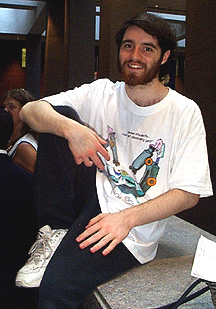 |
| POSTER DAY BROCHURES |
|
Poster Day is an annual event sponsored by the NIH Office of Education (see story). A limited number of brochures listing the titles of the 407 posters, with the names of the students and preceptors, is available from Education Program officer Debbie Cohen. |